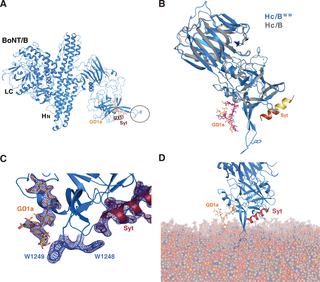PLOS Biology ( IF 7.8 ) Pub Date : 2020-03-17 , DOI: 10.1371/journal.pbio.3000618 Linxiang Yin 1 , Geoffrey Masuyer 2 , Sicai Zhang 1 , Jie Zhang 1 , Shin-Ichiro Miyashita 1 , David Burgin 3 , Laura Lovelock 3 , Shu-Fen Coker 3 , Tian-Min Fu 4 , Pål Stenmark 2, 5 , Min Dong 1

|
Botulinum neurotoxins (BoNTs) are a family of bacterial toxins with seven major serotypes (BoNT/A–G). The ability of these toxins to target and bind to motor nerve terminals is a key factor determining their potency and efficacy. Among these toxins, BoNT/B is one of the two types approved for medical and cosmetic uses. Besides binding to well-established receptors, an extended loop in the C-terminal receptor-binding domain (HC) of BoNT/B (HC/B) has been proposed to also contribute to toxin binding to neurons by interacting with lipid membranes (termed lipid-binding loop [LBL]). Analogous loops exist in the HCs of BoNT/C, D, G, and a chimeric toxin DC. However, it has been challenging to detect and characterize binding of LBLs to lipid membranes. Here, using the nanodisc system and biolayer interferometry assays, we find that HC/DC, C, and G, but not HC/B and HC/D, are capable of binding to receptor-free lipids directly, with HC/DC having the highest level of binding. Mutagenesis studies demonstrate the critical role of consecutive aromatic residues at the tip of the LBL for binding of HC/DC to lipid membranes. Taking advantage of this insight, we then create a “gain-of-function” mutant HC/B by replacing two nonaromatic residues at the tip of its LBL with tryptophan. Cocrystallization studies confirm that these two tryptophan residues do not alter the structure of HC/B or the interactions with its receptors. Such a mutated HC/B gains the ability to bind receptor-free lipid membranes and shows enhanced binding to cultured neurons. Finally, full-length BoNT/B containing two tryptophan mutations in its LBL, together with two additional mutations (E1191M/S1199Y) that increase binding to human receptors, is produced and evaluated in mice in vivo using Digit Abduction Score assays. This mutant toxin shows enhanced efficacy in paralyzing local muscles at the injection site and lower systemic diffusion, thus extending both safety range and duration of paralysis compared with the control BoNT/B. These findings establish a mechanistic understanding of LBL–lipid interactions and create a modified BoNT/B with improved therapeutic efficacy.
中文翻译:

膜结合环的表征导致工程肉毒杆菌神经毒素B具有改善的治疗功效。
肉毒杆菌神经毒素(BoNT)是一类细菌毒素,具有7种主要血清型(BoNT / A–G)。这些毒素靶向并结合运动神经末梢的能力是决定其效力和功效的关键因素。在这些毒素中,BoNT / B是批准用于医疗和化妆品用途的两种类型之一。除了与公认的受体结合外,BoNT / B(H C / B)的C末端受体结合域(H C)中的延伸环也被提议通过与脂质膜相互作用也有助于毒素与神经元的结合。 (称为脂质结合环[LBL])。H C中存在类似的回路BoNT / C,D,G和嵌合毒素DC。然而,检测和表征LBL与脂质膜的结合一直是具有挑战性的。在这里,使用纳米光盘系统和生物层干涉测定法,我们发现H C / DC,C和G,但H C / B和H C / D不能与H C直接结合至无受体脂质/ DC具有最高级别的绑定。诱变研究表明,LBL末端连续的芳香族残基对于H C / DC与脂质膜的结合具有至关重要的作用。利用这一见解,我们然后创建一个“功能获得”突变体H C/ B通过用色氨酸替换LBL末端的两个非芳族残基。共结晶研究证实,这两个色氨酸残基不会改变H C / B的结构或与其受体的相互作用。如此突变的H C/ B获得了结合无受体脂质膜的能力,并显示出与培养的神经元的增强结合。最后,在小鼠体内使用数字诱拐得分测定法产生并评估了全长BoNT / B,该全长BoNT / B在其LBL中包含两个色氨酸突变,以及两个另外的增加与人类受体结合的突变(E1191M / S1199Y)。这种突变毒素显示出增强的麻痹注射部位局部肌肉的功效,并降低了全身扩散,因此与对照BoNT / B相比,既延长了安全范围,又延长了麻痹的持续时间。这些发现建立了对LBL-脂质相互作用的机械理解,并创建了一种改良的BoNT / B,具有更高的治疗功效。











































 京公网安备 11010802027423号
京公网安备 11010802027423号